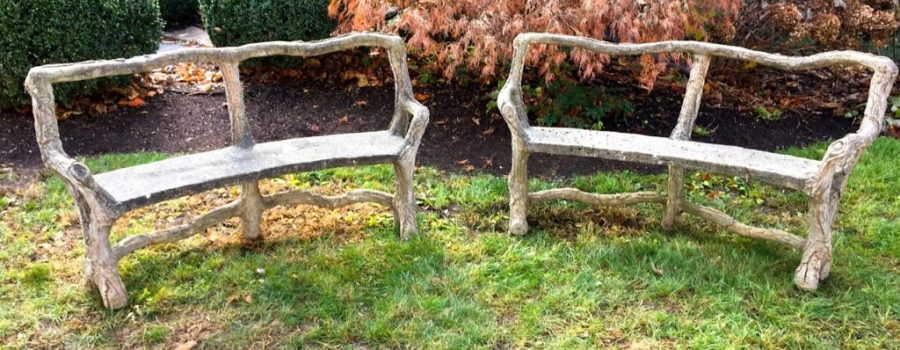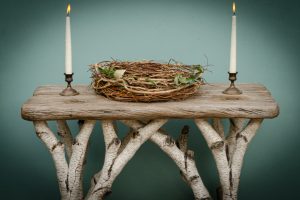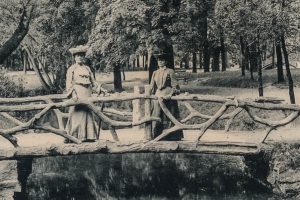Garden antiques expert Tracey Young tells about the best way to take care of your vintage faux bois furniture
Note: Whenever I create a concrete faux bois bench or other furniture, I owe a debt to the artisans 100 years ago for creating the works that are now treasured heirlooms throughout the world.
Their work has fueled my imagination made me feel connected to a rich heritage of ferrocement craftsmanship which began in France in 1849.
I feel very protective of antique faux bois. After a century of being outside, some of this artwork is at risk from the elements and in need of proper TLC and in some cases restoration.
If you ask me about the best way to care for or restore that faux bois bench you just inherited, I would have to admit that it is not within my area of expertise. The high tech, high performance cement mixes I use are vastly different than the simple mortar mixes of old.
To properly address this important issue, I interviewed garden antiques expert Tracey Young, Co-owner and Managing Director of The Elemental Garden in Woodbury, CT, the largest American purveyor of 18th – mid-20th century antiques. For several decades, Tracey has purchased and sold high quality antique faux bois to well known interior designers, architects, landscape designers, and even celebrities. I hope her insights will raise awareness and help protect the legacy of this unique art form.
–Diane Husson, faux bois sculptor
Are antique faux bois furniture pieces mostly decorative, or do owners use them every day?
Absolutely, people use them every day, as they should! When in good condition, antique faux bois garden furniture is quite durable and although many people buy faux bois because they are attracted to the way it looks, we are firm believers in using garden antiques. Of course, looking at lovely pieces is also a great form of enjoyment!
Does antique faux bois furniture need to be brought in during the winter?
Unequivocally YES if you live in a climate where it freezes.
All faux bois planters and fountains should be emptied of plants, dirt and water at the end of each growing season, and then preferably placed indoors. If they are left outside, they should be thoroughly dried and then covered with a waterproof tarp. Knowing when a faux bois piece is sufficiently dry to cover is a fool’s errand, so we recommend bringing all pieces inside around October in colder climates and then setting them out in April when it warms up.
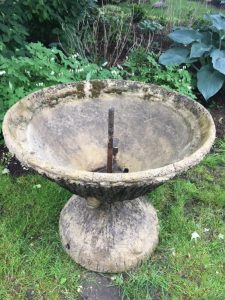
A functional 1950s faux bois water fountain
What if someone lives in temperate southern climates?
Determining what is “temperate” can be tricky. I would say that certainly antique faux bois can safely be left outside in Florida, Arizona, Southern California and parts of Texas…those states are pretty much immune to repeated freeze-thaw cycles which are the natural enemy of faux bois. I would not leave faux bois outside in Zones 7 or less.
Is there any other way to prevent weather damage or take care of an old faux bois bench or other antique garden furniture?
There is a great sealant on the market now called Permalac and it comes in a matte finish. Buy the liquid in a gallon can, not the spray cans. You can paint it on DRY faux bois furniture (but not over moss) and it will retain the patina and help protect it from absorbing water. It will not negatively affect the patina. Apply 2-3 coats every 2 years and you should be good to go. It’s not an absolute cure for water, but then, nothing is foolproof except bringing that faux bois bench and other pieces indoors prior to cold weather setting in.
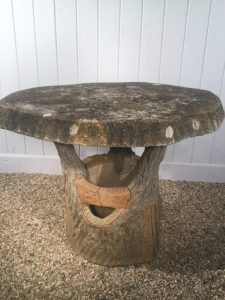
A faux bois dining table, CA 1960-1970.
What are some tips for routine care of antique faux bois furniture? Is there a way to get pollen or bird droppings off of a faux bois bench, chair or table without ruining the lovely moss and patina?
One should care for faux bois furniture pieces by looking at them closely at least once a year to see if they have developed any cracks or breaks. Catching the cracks early is the best way to keep your antique faux bois in tip-top condition. These need to be repaired as soon as they are noticed to avoid further damage. We have an expert faux bois restorer that can fix anything!
I’m not a big believer in cleaning faux bois, but if it is necessary, a soft toothbrush with warm water will remove most bird droppings. Also, a soft hand broom is useful for cleaning off pollen. Start gently and with a small spot and move on from there if your initial efforts are good.
If you place a faux bois bench in the garden, should you put a brick or paver under the legs to keep them from sitting in a pool of water if it rains?
Always place faux bois pieces on concrete footings, bluestone, or even gravel to mitigate the wicking of water up inside the bottom of the pieces. The harder the stone, the better. Bricks are porous so are not a good long-term solution, but concrete pavers are excellent.
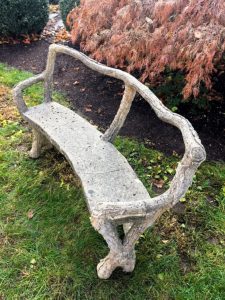
1950s faux bois bench
What should you avoid doing at all costs to your faux bois?
Keep dirt and grass away from the edges of the feet or bottom of your faux bois. Placing antique faux bois in contact with dirt or grass for more than a couple of months is a sure-fired way to invite cracking.
Antique faux bois is made from porous hand-carved and colored concrete that is formed over an iron armature. When water wicks up through the bottom and then freezes inside, the iron armature begins rust, swell and expand radially. This puts pressure on the faux bois from the inside and then repeated freeze-thaw cycles will invariably cause cracking in the concrete.
What is the best way to move my faux bois furniture?
Keep in mind that antique faux bois pieces are actually quite fragile and should be transported with great care, a large amount of packing, and by someone who knows how to handle these types of pieces.
If an antique piece is damaged, where can they go to get it professionally restored?
Professional antique garden dealers generally have access to a good faux bois restorer, but they are rare as hen’s teeth, and therefore, remain a closely-guarded secret. Also, they are not cheap. If you buy a piece of faux bois from The Elemental Garden, then you will, of course, have access to our fabulous restorer if need be.
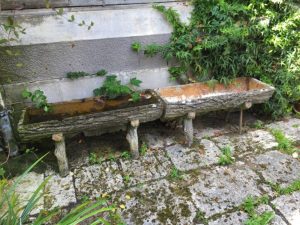
Pair of “split-log” faux bois planters before restoration
Do you have any final words or insights regarding the care of antique faux bois?
Unfortunately people ignore our advice on caring for their antique faux bois pieces all the time and they do so at their peril. If people are not willing to follow instructions, they should avoid faux bois or any other antique garden piece.
Remember, most antique faux bois, like most other antique garden pieces, were made in France or England, which do not have intemperate climates like the US. Maintenance is the key to a beautiful garden and to beautiful garden antiques staying beautiful. It’s just like getting a facelift for the first time at age 75. You won’t see the same results as if you had it done when you were 45!
All photos courtesy of Tracey Young. Tracey can be contacted through The Elemental Garden.
(A note from Diane: The information in this article is dedicated to antique faux bois furniture. Instructions regarding the maintenance of contemporary pieces should be directed toward the artisan herself or the dealer who sold you the piece.)
Diane Husson is a concrete sculptor specializing in the design and creation of contemporary faux bois benches and other faux bois furniture and accessories. She lives in Norfolk, Virginia. If you are interested in finding out more about her work you may contact her at dianehusson@cox.net
